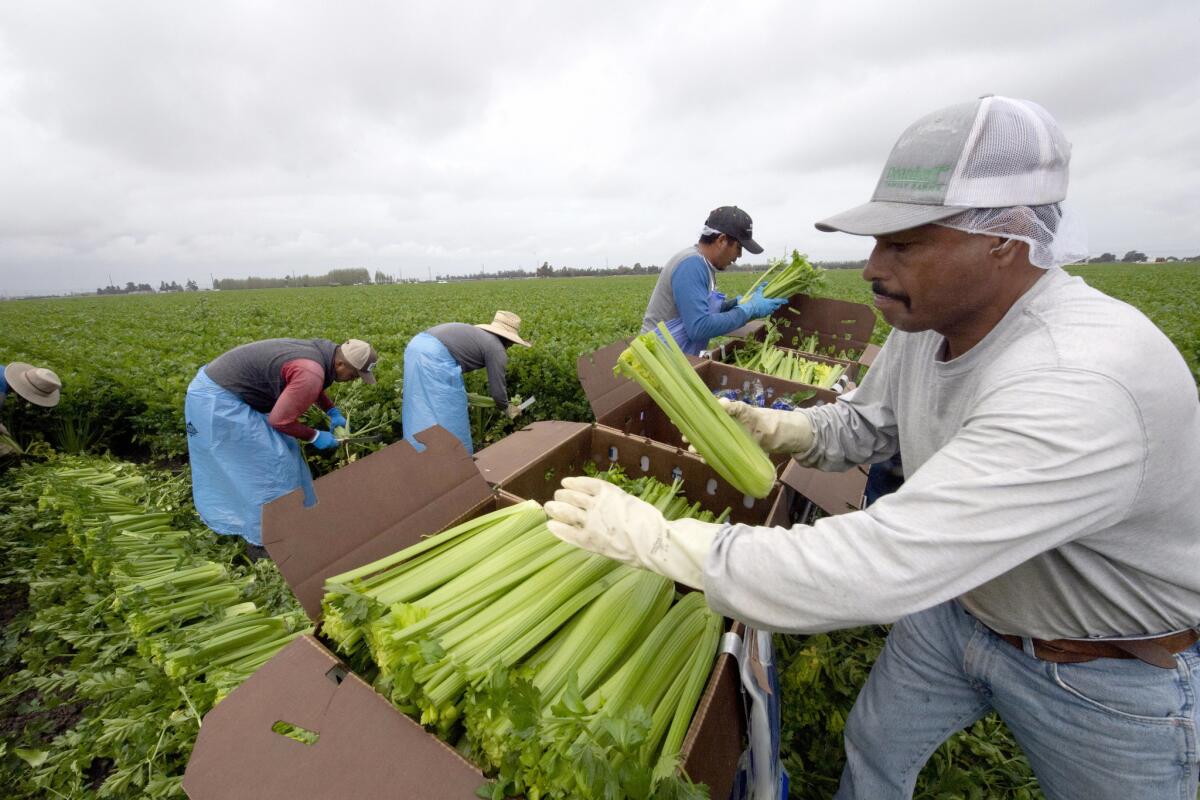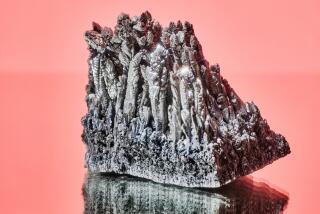Everything you didn’t even know you wanted to know about celery
Suddenly, celery’s all the rage.
Anthony William, the “Medical Medium” who converses with spirits, has inspired masses to drink big glasses of straight celery juice on an empty stomach every day, hoping to cure manifold ills. This may sound like a goofy sitcom plot, but celery’s wholesale price has soared tenfold in the last year, and supermarkets sometimes sell out. The most commonplace of vegetables has become an improbable star.
Cynthia Yedinak, a 32-year-old “integrative nutrition health coach” who was buying celery at the Hollywood farmers market on a recent Sunday, described the benefits she has experienced drinking the juice. “I wake up ready to go, with a clearer head, and have better memory, clearer skin and no bloating,” she said.
The history of celery is rife with such metamorphoses, booms and outlandish claims, some surprisingly local. Celery was claimed to purify blood, calm nerves and relieve stomach disorders, and celery nostrums proliferated, starting in 1868 with a tonic that remains popular today as Dr. Brown’s Cel-Ray soda. In the 1880s Colonel M.K. Paine made millions on his Celery Compound, which included cocaine and promised to cure everything from scrofula to piles. In 1903 Dr. Price launched a celery-flavored cereal, Tryabita, and a celery-flavored gum, Tryachewa — both, not surprisingly, flops.
In the 1930s and ’40s, when Los Angeles was the leading agricultural county in the nation, celery was its largest vegetable crop and Venice was the prime growing area. Yet the tale of celery’s glory years has remained untold.
Celery is an extreme example of man’s transformation of plants. Kin to carrots, parsley, parsnips and dill, celery grows wild in moist, salty soils in Europe and Western Asia. It started out as a bitter, semi-poisonous weed with thin, hollow stalks (botanically petioles), and was used by the ancients for ornamentation, for medical properties and as a condiment.
In the 1930s and ’40s, when Los Angeles was the leading agricultural county in the nation, celery was its largest vegetable crop
Celery was rare in the United States in the early 19th century because it was grown in trenches — blanched, or covered with a cloth so as to prevent photosynthesis and keep it pale in color, as is still done for endive today. This process was difficult and expensive, so celery was a luxury, and through the end of the century it was displayed on the dining tables of the wealthy in ornate celery vases.
The huge celery boom came in the 1880s and 1890s with the advent of “self-blanching” varieties, denser plantings and the use of boards to shade the stalks. A dozen books on the “New Celery Culture” appeared, cultivation surged and celery became readily available at moderate prices.
1891 — Celery farming begins in California
In California, celery farming began in 1891 in Westminster, where newly drained bogs provided fertile and easily worked ground. Cultivation soon spread to Chula Vista and El Monte.
In the early 1910s, as farmland in the West Adams district was developed for housing, Japanese immigrants started migrating to the Venice area to grow celery. This area — from Venice Boulevard to Jefferson Boulevard, from Overland Avenue to the ocean — soon led the Southland in celery production. Gardena and Compton also became important districts.
The Venice Celery Farmers Assn., founded in 1921, had an office near where Gold’s Gym stands today, and Venice Celery Distributors shipped around the country by rail from a warehouse on San Pedro Street in downtown. Its Venice Belle Celery labels from the late 1930s depict a gorgeous celluloid goddess of celery.
Celery acreage in Los Angeles fluctuated considerably because of disease and competitive pressures, peaking at 3,105 in 1933. In the early years growers used boards and earth to produce white or golden celery, but the old varieties suited for this, White Plume and Golden Self-Blanching, were highly susceptible to disease. In the 1930s growers shifted to varieties derived from Giant Pascal, such as Tall Utah, that were more resistant, productive and kept well. This “Pascal celery” was also cheaper to grow because it produced high-quality green stalks without blanching, similar to what we eat today, and by 1940 five-sixths of the Los Angeles crop was green.
1942 — Celery cultivation in California slows down
Celery cultivation flourished until spring 1942, when Japanese-Americans on the West Coast were forced into internment camps.
“When we were ordered to be interned, the celery crops were ready to harvest, but I don’t know by whom or how they were harvested and sold,” recalls Ray Uyemori, 88, whose grandfather and father grew celery near Olympic Boulevard and Centinela Avenue.
In 1945 the family was able to return and resume growing celery, although part of their land had been taken during the war for a Douglas Aircraft warehouse.
Celery cultivation in Los Angeles held steady until 1951, gradually declined for the rest of the decade, and then plummeted as houses replaced farms. Blanching ceased completely. Growers moved to Orange and Ventura counties, and by 1969 only 12 acres of celery farming remained in L.A.
Today — California still grows most of the nation’s celery
Today California grows about 28,000 acres of celery and accounts for 80% of the United States supply; Mexico, Arizona, Michigan and Florida produce the rest. The main growing areas in California are cool coastal districts: Salinas and Santa Maria, where the season is mid-June to early November, and Ventura County, which picks from November to mid-July.
The celery harvest resembles ballet with machetes. Recently, on a cool, cloudy morning at Deardorff Family Farms in Oxnard, the uniform, densely packed celery plants — 44,000 per acre — spread to the horizon like a knee-high forest, wafting a herbaceous aroma, subtle yet powerful. Expertly, each picker swiftly used the end of his razor-sharp celery knife to slice a plant out of the ground at the root; scrutinized it to make sure it had not started to go to seed; precisely chopped off the remaining root and the leaves, using the knife’s side blade; and placed the trimmed stalk in a row on the ground. A packer soon picked it up, instantly assessed its size, and put it in the corresponding carton, borne on a giant cart called the hump, pushed by hand.

Co-owner Scott Deardorff, 56, surveyed the action with mixed satisfaction and apprehension. Because of an atypically cold winter, many of the plants were “seeders” that had bolted and lay discarded. The pressure was on to fill orders, because the price for a 57-pound carton was an unprecedented $60 to $75. This was up from $6 to $8 a year before, so low that growers reduced plantings.
The harvest ends abruptly on July 14, because from July 15 to Aug. 14, growers are forbidden to grow celery in Ventura County as part of a state-mandated “host-free period” that breaks the transmission of celery mosaic virus. During that time the county agricultural commissioner’s office also hires students to eradicate wild celery from parks and ditch banks, said Ellen Kragh, deputy agricultural commissioner.
There’s no such restriction in Santa Barbara County, which supplies much of the celery sold at Los Angeles farmers markets. Farmers market celery typically is fresher and thus more aromatic than store-bought stalks, but can be more variable in quality. The best artisanal growers, such as Finley Farms and The Garden of….., produce celery that is small but rich in flavor, starting in summer or early fall. In less expert hands, celery exposed to frost can be pithy, with a white, dry center; heat and lack of water, or overmaturity, can cause bitterness; and irrigation with saline groundwater can impart excessive saltiness.
In the cooler months, farmers markets are a good source of celery root, or celeriac, which is produced by plants of the same species (Apium graveolens) as regular celery, but a different type in which the base of the stem and upper root are greatly enlarged. There and at Asian markets one can also find Chinese celery, which was domesticated separately and is different from the celery cultivated in Europe and the United States; it has hollow, skinny, stemlike stalks, with more intense flavor, and is used in soups and stews.
Regular celery mostly derives from a narrow genetic base, from Giant Pascal, a French variety discovered in 1884, with a smidgen of celeriac for disease resistance. The major varieties grown in California, such as Mission, Command, Sonora, and Conquistador, are so similar that they are rarely marketed by name.
Just a few California farms produce heirloom or unusual celery. Martin’s Farm in Salinas grows Giant Red, an heirloom that looks like rhubarb, and Dorato Gigante, a yellowish-green variety from Italy. “They have profound, intense flavor only hinted at with the current kind of celery,” said farmer-owner Martin Bournhonesque.
Aaron Choi of Girl & Dug Farm in San Marcos raises greenhouse-grown white and Chinese Pink celery, which he cuts when the stalks are 4 to 5 inches long — “just small enough to serve as a functional garnish,” he said.
Choi, who sells to restaurants such as Rustic Canyon and Nightshade, has tried blanching celery. “The entire stalk become noticeably more tender, a little less fibrous, milder and sweeter,” he said.
While these few are pursuing bygone arts, millions of fervid converts are juicing celery, and the Medical Medium’s new book on celery is already being touted as a bestseller.
Recent, peer-reviewed scientific articles do maintain that celery is rich in minerals and vitamins; is a strong antioxidant and can scavenge free radicals; can improve hypertension and protect against cardiovascular disease; can accelerate bone healing; and can protect against oxidative damage to the brain.
How celery became the unlikely star of the produce aisle »
But almost every fruit and vegetable, when studied, is found to have beneficial effects, and nutritionists generally discourage making a fetish of any particular food.
From the nutritional and phytochemical standpoints, there’s “nothing superior” about celery, said Dr. Zhaoping Li, director of the Center for Human Nutrition at UCLA. The downside of consuming large amounts of celery juice, she added, would be “missing nutrients from other vegetables.”
Whatever its health effects, and even if the current craze subsides, celery’s colorful history and local provenance should add to the pleasure of its consumption.
More to Read
Eat your way across L.A.
Get our weekly Tasting Notes newsletter for reviews, news and more.
You may occasionally receive promotional content from the Los Angeles Times.






